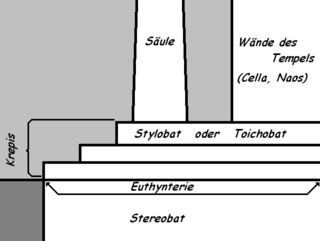Krepis
As Krepis ( Greek ἡ κρηπίς fem. - shoe, base, foundation), also Krepidoma ( Greek τὸ κρηπίδωμα neutr. - foundation, base), the step substructure of the Greek temple is called.
The Krepis rests on the euthyntery , the smooth top layer of the foundation , also known as the stereobat . Since the time of the Greek classical period , the Krepis usually comprises three stages. To emphasize it, the top one is often a little higher than the lower steps. Depending on the building context, the top level can be addressed differently. If there are columns on the rows of plates on the top tier - for example in a ring hall temple, Peripteros - they are called stylobate . In temples without a ring hall, however, the top step of the Krepis also supported the bottom layer of the wall. This is why it is also known as toichobat in the case of temple or double- sided temple .
literature
- Gottfried Gruben : The temples of the Greeks . Hirmer, Munich 2001 (5th edition), ISBN 3-777-48460-1
- Heiner Knell : Architecture of the Greeks: Basic features . Scientific Book Society, Darmstadt 1988, ISBN 3-534-80028-1
- Wolfgang Müller-Wiener , Greek civil engineering in antiquity . CH Beck, Munich 1988, ISBN 3-406-32993-4
